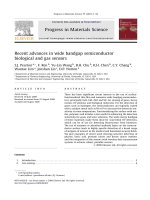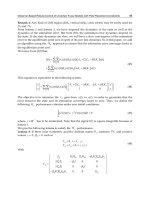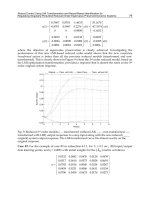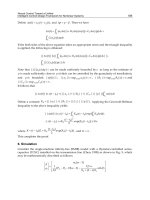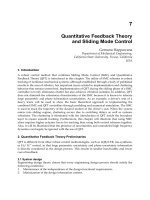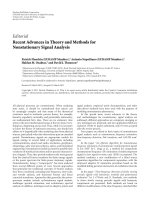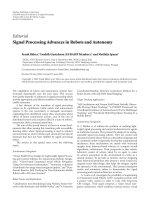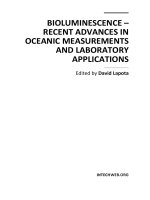FUZZY CONTROLLERS – RECENT ADVANCES IN THEORY AND APPLICATIONS pdf
Bạn đang xem bản rút gọn của tài liệu. Xem và tải ngay bản đầy đủ của tài liệu tại đây (32.38 MB, 590 trang )
FUZZY CONTROLLERS –
RECENT ADVANCES IN
THEORY AND
APPLICATIONS
Edited by Sohail Iqbal, Nora Bumella
and Juan Carlos Fiueroa Garcia
Fuzzy Controllers – Recent Advances in Theory and Applications
Edited by Sohail Iqbal, Nora Bumella and Juan Carlos Fiueroa Garcia
Contributors
Teodor Lucian Grigorie, Ruxandra Mihaela Botez, Andrei Vladimir Popov, Stela Rusu-Anghel,
Lucian Gherman, Omer Aydogdu, Ramazan Akkaya, M.H. Fazel Zarandi, Fereidoon Moghadas
Nejad, H. Zakeri, Xin Wang, Edwin E. Yaz, James Long, Tim Miller, S. Bouallègue, J. Haggège,
M. Benrejeb, Meriem Nachidi, Ahmed El Hajjaji, Ying-Shieh Kung, Chung-Chun Huang, Liang-
Chiao Huang, Ping Zhang, Guodong Gao, Maguid H. M. Hassan, M. Chadli, A. El Hajjaji, Pedro
Ponce, Arturo Molina, Rafael Mendoza, Kwanchai Sinthipsomboon, Issaree Hunsacharoonroj,
Josept Khedari, Watcharin Po-ngaen, Pornjit Pratumsuwan, Yousif I. Al Mashhadany, Carlos
André Guerra Fonseca, Fábio Meneghetti Ugulino de Araújo, Marconi Câmara Rodrigues, Nora
Boumella, Juan Carlos Figueroa, Sohail Iqbal, Muhammad M.A.S. Mahmoud, Morteza Seidi,
Marzieh Hajiaghamemar, Bruce Segee, Wudhichai Assawinchaichote, Yassine Manai,
Mohamed Benrejeb, Mavungu Masiala, Mohsen Ghribi, Azeddine Kaddouri, Georgios A.
Tsengenes, Georgios A. Adamidis, B. S. K. K. Ibrahim, M. O. Tokhi, M. S. Huq, S. C. Gharooni,
José Luis Azcue, Alfeu J. Sguarezi Filho, Ernesto Ruppert
Published by InTech
Janeza Trdine 9, 51000 Rijeka, Croatia
Copyright © 2012 InTech
All chapters are Open Access distributed under the Creative Commons Attribution 3.0 license,
which allows users to download, copy and build upon published articles even for commercial
purposes, as long as the author and publisher are properly credited, which ensures maximum
dissemination and a wider impact of our publications. After this work has been published by
InTech, authors have the right to republish it, in whole or part, in any publication of which they
are the author, and to make other personal use of the work. Any republication, referencing or
personal use of the work must explicitly identify the original source.
Notice
Statements and opinions expressed in the chapters are these of the individual contributors and
not necessarily those of the editors or publisher. No responsibility is accepted for the accuracy
of information contained in the published chapters. The publisher assumes no responsibility for
any damage or injury to persons or property arising out of the use of any materials,
instructions, methods or ideas contained in the book.
Publishing Process Manager Iva Simcic
Typesetting InTech Prepress, Novi Sad
Cover InTech Design Team
First published September, 2012
Printed in Croatia
A free online edition of this book is available at www.intechopen.com
Additional hard copies can be obtained from
Fuzzy Controllers – Recent Advances in Theory and Applications,
Edited by Sohail Iqbal, Nora Bumella and Juan Carlos Fiueroa Garcia
p. cm.
ISBN 978-953-51-0759-0
Contents
Preface IX
Chapter 1 Fuzzy Logic Control of a Smart
Actuation System in a Morphing Wing 1
Teodor Lucian Grigorie, Ruxandra Mihaela Botez
and Andrei Vladimir Popov
Chapter 2 Embedded Fuzzy Logic Controllers
in Electric Railway Transportation Systems 23
Stela Rusu-Anghel and Lucian Gherman
Chapter 3 Design of a Real Coded GA Based Fuzzy Controller
for Speed Control of a Brushless DC Motor 63
Omer Aydogdu and Ramazan Akkaya
Chapter 4 A Type-2 Fuzzy Model Based
on Three Dimensional Membership Functions
for Smart Thresholding in Control Systems 85
M.H. Fazel Zarandi, Fereidoon Moghadas Nejad and H. Zakeri
Chapter 5 Fuzzy Control of Nonlinear Systems
with General Performance Criteria 119
Xin Wang, Edwin E. Yaz, James Long and Tim Miller
Chapter 6 A New Method for Tuning PID-Type Fuzzy Controllers
Using Particle Swarm Optimization 139
S. Bouallègue, J. Haggège and M. Benrejeb
Chapter 7 Output Tracking Control for Fuzzy Systems
via Static-Output Feedback Design 163
Meriem Nachidi and Ahmed El Hajjaji
Chapter 8 FPGA-Based Motion Control IC for Linear Motor
Drive X-Y Table Using Adaptive Fuzzy Control 181
Ying-Shieh Kung, Chung-Chun Huang and Liang-Chiao Huang
VI Contents
Chapter 9 Novel Yinger Learning Variable
Universe Fuzzy Controller 201
Ping Zhang and Guodong Gao
Chapter 10 Fuzzy Controllers: A Reliable Component
of Smart Sustainable Structural Systems 221
Maguid H. M. Hassan
Chapter 11 Vehicle Fault Tolerant Control Using
a Robust Output Fuzzy Controller Design 249
M. Chadli and A. El Hajjaji
Chapter 12 Wheelchair and Virtual Environment
Trainer by Intelligent Control 271
Pedro Ponce, Arturo Molina and Rafael Mendoza
Chapter 13 A Hybrid of Fuzzy and Fuzzy Self-Tuning PID Controller
for Servo Electro-Hydraulic System 299
Kwanchai Sinthipsomboon, Issaree Hunsacharoonroj,
Josept Khedari, Watcharin Po-ngaen and Pornjit Pratumsuwan
Chapter 14 Design and Simulation of Anfis Controller
for Virtual-Reality-Built Manipulator 315
Yousif I. Al Mashhadany
Chapter 15 Hierarchical Fuzzy Control 335
Carlos André Guerra Fonseca, Fábio Meneghetti Ugulino de Araújo
and Marconi Câmara Rodrigues
Chapter 16 Enhancing Fuzzy Controllers Using Generalized
Orthogonality Principle 367
Nora Boumella, Juan Carlos Figueroa and Sohail Iqbal
Chapter 17 New Areas in Fuzzy Application 385
Muhammad M.A.S. Mahmoud
Chapter 18 Fuzzy Control Systems: LMI-Based Design 441
Morteza Seidi, Marzieh Hajiaghamemar and Bruce Segee
Chapter 19 New Results on Robust
∞
Filter
for Uncertain Fuzzy Descriptor Systems 465
Wudhichai Assawinchaichote
Chapter 20 Robust Stabilization for Uncertain
Takagi-Sugeno Fuzzy Continuous Model
with Time-Delay Based on Razumikhin Theorem 481
Yassine Manai and Mohamed Benrejeb
Contents VII
Chapter 21 A Two-Layered Load and Frequency
Controller of a Power System 503
Mavungu Masiala, Mohsen Ghribi and Azeddine Kaddouri
Chapter 22 Performance Evaluation of PI
and Fuzzy Controlled Power Electronic
Inverters for Power Quality Improvement 519
Georgios A. Tsengenes and Georgios A. Adamidis
Chapter 23 Discrete-Time Cycle-to-Cycle Fuzzy Logic
Control of FES-Induced Swinging Motion 541
B. S. K. K. Ibrahim, M. O. Tokhi, M. S. Huq and S. C. Gharooni
Chapter 24 Three Types of Fuzzy Controllers Applied
in High-Performance Electric Drives
for Three-Phase Induction Motors 559
José Luis Azcue, Alfeu J. Sguarezi Filho and Ernesto Ruppert
Preface
At the core of many engineering problems is the problem of control of different
systems. These systems range all the way from classical inverted pendulum to auto-
focusing system of a digital camera. Fuzzy control systems have demonstrated their
enhanced performance in all these areas. Although initially fuzzy systems were
associated only to the artificial intelligence that has refrained to the development of
theoretical fuzzy systems, in 1985 Japanese researchers Seiji Yasunobu and Soji
Miyamoto demonstrated the superiority of fuzzy control systems for the Sendai
railway. From that moment on, many applications have taken the advantage of the
inherent potential offered by fuzzy controllers. Some notable works on the
applications of fuzzy controllers are inverted pendulum balancing by Takeshi
Yamakawa, improved vacuum cleaners by Panasonic corporation, stable CCD
development by Canon Inc., energy efficient air conditioners by Mitsubishi Companies
and fuel efficient automatic space docking by NASA.
Since fuzzy controllers have proven their performance in many domains of science
and technology, it has led to further development of the theory of fuzzy systems to
solve even more intricate problems. In this book, our purpose is to present the recent
developments both in theory and applications of fuzzy controllers. The book is a
collection of chapters which are the result of the coordinated work of scholars
worldwide. Each chapter presents a different application of fuzzy controllers along
with the necessary development of the theory. Any reader can study every chapter of
this book as a self-contained research work. Moreover, this book can be recommended
to students who have done the basics of fuzzy set theory earlier on and now they want
to apply it. Reading of the entire book will provide you with a variety of ideas to
develop theory and apply it to fuzzy control problems.
This book starts with theory development and its application to solve an aerospace
engineering problem, then a fuzzy controller is used in electric railway transportation.
In the subsequent chapters, further theory and its applications to solve a variety of
problems are presented. These problems include the fault tolerant control of a vehicle,
integral wheelchair control, and hierarchical fuzzy control among others. Book
concludes with a chapter on describing the new areas in fuzzy controllers.
Reviewing all the received chapters, proposing improvements, and all the tasks of
book editing within few months were not possible without the dedicated efforts of my
X Preface
colleagues and co-editors of the book Nora Boumella and Juan Carlos Figueroa García.
I am thankful to both for their commitment to excellence.
During the review of the book chapters and book editing Iva Simcic, publishing
process manager of INTECH, provided fast and efficient feedback and guidance. I
would like to thank her for her professionalism.
Special thanks to my teachers Sarmad Abbasi and Yacine Amirat for guiding me to
understand the techniques of scientific research. I would also like to express my
gratitude to Arshad Ali, principal NUST School of Electrical Engineering and
Computer Science who always encourage faculty to take initiatives to promote a
culture of scientific investigation.
I am highly indebted to Higher Education Commission of Pakistan for revolutionizing
the science and technology. Moreover, I am also thankful to National University of
Sciences and Technology, Pakistan for providing an idea environment for research and
development.
Sohail Iqbal
National University of Science and Technology,
Pakistan
Nora Boumella
University of Batna, Batna,
Algeria
Juan Carlos Figueroa-García
Universidad Distrital Francisco Jose de Caldas, Bogota,
Colombia
Chapter 1
© 2012 Botez et al., licensee InTech. This is an open access chapter distributed under the terms of the
Creative Commons Attribution License ( which permits
unrestricted use, distribution, and reproduction in any medium, provided the original work is properly cited.
Fuzzy Logic Control of a Smart
Actuation System in a Morphing Wing
Teodor Lucian Grigorie, Ruxandra Mihaela Botez and Andrei Vladimir Popov
Additional information is available at the end of the chapter
1. Introduction
The actual trends in aerospace engineering are related to the green aircrafts development
and to theirs' constructive parts optimization in order to obtain important fuel and energy
savings. A lot of these studies refer to the aircrafts' shape optimization, taking into
account that the aircraft drag force influences directly the fuel consumption. In this way, a
very interesting and provocative concept was launched on the market, i.e. "morphing
aircraft". Considering the drag reduction, fuel consumption economy and flight envelope
increasing promising benefits, many universities, R&D institutions and industry initiated
and developed morphing aircrafts studies in the last decade (Munday and Jacob, 2002;
Sanders, 2003; Manzo et al., 2004; Skillen and Crossley, 2005; Bornengo et al., 2005;
Moorhouse et al., 2006; Namgoong et al., 2006; Namgoong et al., 2007; Seigler et al., 2007;
Obradovic and Subbarao, 2011 a; Obradovic and Subbarao, 2011 b; Gamboa et al., 2009;
Baldelli at al., 2008; Inoyama et al., 2008; Thill et al., 2008; Perera and Guo, 2009; Bilgen et
al., 2009; Bilgen et al., 2010; Thill et al., 2010; Seber and Sakarya, 2010; Wildschek et al.,
2010; Ahmed et al., 2011). The multidisciplinary aspects involved by such studies, bring
together research teams in many fields of the science: aerodynamics and aeroelasticity,
automation, electrical engineering, materials engineering, control and software
engineering. Categorized as a part of the “Smart structures” engineering field, the general
concept of morphing aircrafts includes some particular elements, as a function by the
complexity of the developed morphing application. Recent researches in smart materials
and adaptive structures fields have led to a new way to obtain a morphing aircraft by
changing the shape of its wings through the control of the airfoils cambers; the concept
was called “morphing wing”. Therefore, a lot of architecture were and are still imagined,
designed, studied and developed, for this new concept application. One of these is our
team project including the numerical simulations and experimental multidisciplinary
studies using the wind tunnel for a morphing wing equipped with a flexible skin, smart
Fuzzy Controllers – Recent Advances in Theory and Applications
2
material actuators and pressure sensors. The aim of these studies is to develop an
automatic system that, based on the information related to the pressure distribution along
the wing chord, moves the transition point from the laminar to the turbulent regime closer
to the trailing edge in order to obtain a larger laminar flow region, and, as a consequence,
a drag reduction.
The objective of the research presented here is to develop a new morphing mechanism using
smart materials such as Shape Memory Alloy (SMA) as actuators and fuzzy logic
techniques. These smart actuators deform the upper wing surface, made of a flexible skin, so
that the laminar-to-turbulent transition point moves closer to the wing trailing edge. The
ultimate goal of this research project is to achieve drag reduction as a function of flow
condition by changing the wing shape. The transition location detection is based on pressure
signals measured by optical and Kulite sensors installed on the upper wing flexible surface.
Depending on the project evolution phase, two architectures are considered for the
morphing system: open loop and closed loop. The difference between these two
architectures is their use of the transition point as a feedback signal. This research work was
a part of a morphing wing project developed by the Ecole de Technologie Supérieure in
Montréal, Canada, in collaboration with the Ecole Polytechnique in Montréal and the
Institute for Aerospace Research at the National Research Council Canada (IAR-NRC)
(Brailovski et al., 2008; Coutu et al., 2007; Coutu et al., 2009; Georges et al., 2009; Grigorie &
Botez, 2009; Grigorie & Botez, 2010; Grigorie et al., 2010 a; Grigorie et al., 2010 b; Grigorie et
al., 2010 c; Popov et al., 2008 a; Popov et al., 2008 b; Popov et al., 2009 a; Popov et al., 2009 b;
Popov et al., 2010 a; Popov et al., 2010 b; Popov et al., 2010 c; Sainmont et. al., 2009), initiated
and financially supported by the following government and industry associations: the
Consortium for Research and Innovation in Aerospace in Quebec (CRIAQ), the National
Sciences and Engineering Research Council of Canada (NSERC), Bombardier Aerospace,
Thales Avionics, and the National Research Council Canada Institute for Aerospace
Research (NRC-IAR).
2. Architecture of the controlled structure
To achieve the aerodynamic imposed purpose in the project, a first phase of the studies
involved the determination of some optimized airfoils available for 35 different flow
conditions (five Mach numbers and seven angles of attack combinations). The optimized
airfoils were derived from a laminar WTEA-TE1 reference airfoil (Khalid & Jones, 1993 a;
Khalid & Jones, 1993 b), and were used as a starting point for the actuation system
design.
The chosen wing model was a rectangular one, with a chord of 0.5 m and a span of 0.9 m.
The model was equipped with a flexible skin made of composite materials (layers of carbon
and Kevlar fibers in a resin matrix) morphed by two actuation lines (Fig. 1). Each of our
actuation lines uses three shape memory alloys wires (1.8 m in length) as actuators,
connected to a current controllable power supply. Also, each line contains a cam, which
moves in translation relative to the structure. The cam causes the movement of a rod related
Fuzzy Logic Control of a Smart Actuation System in a Morphing Wing
3
on the roller and on the skin. The recall used is a gas spring. So, when the SMA is heating
the actuator contracts and the cam moves to the right, resulting in the rise of the roller and
the displacement of the skin upwards. In contrast, the cooling of the SMA results in a
movement of the cam to the left, and thus a movement of the skin down. The horizontal
displacement of each actuator is converted into a vertical displacement at a rate 3:1 (results a
cam factor c
f=1/3). From the optimized airfoils, an approximately 8 mm maximum vertical
displacement was obtained for the rods, so, a 24 mm maximum horizontal displacement
should be actuated.
In the same time, 32 pressure sensors (16 optical sensors and 16 Kulite sensors), were
disposed on the flexible skin in different positions along of the chord. The sensors are
positioned on two diagonal lines at an angle of 15 degrees from centreline (Fig. 2). The rigid
lower structure was made from Aluminium, and was designed to allow space for the
actuation system and wiring (Fig. 3).
Figure 1. Model of the flexible structure.
Starting from the reference airfoil, depending on different flow conditions, 35 optimized
airfoils were calculated for the desired morphed positions of the airfoil. The flow conditions
were established as combinations of seven incidence angles (-1, -0.5, 0, 0.5, 1, 1.5, 2) and
five Mach numbers (0.2, 0.225, 0.25, 0.275, 0.3). Each of the calculated optimized airfoils
should be able to keep the transition point as much as possible near the trailing edge.
airfoil
leading edge
Airfoil lower
surface (rigid)
Actuation
points
First
actuating line
From power
supply #1
From power
supply #2
Second
actuating line
Gas springs
SMA actuators
Airfoil trailing
edge
Airfoil uper surface - flexible
skin part (morphed)
Airfoil uper surface
(rigid part)
roller
rod
cam
Fuzzy Controllers – Recent Advances in Theory and Applications
4
Figure 2. Pressure sensors distribution on the flexible skin
Figure 3. Cross section of the morphing wing model.
The SMA actuator wires are made of nickel-titanium, and contract like muscles when
electrically driven. Also, these have the ability to personalize the association of deflections
with the applied forces, providing in this way a variety of shapes and sizes extremely useful
to achieve actuation system goals. How the SMA wires provide high forces with the price of
small strains, to achieve the right balance between the forces and the deformations, required
by the actuation system, a compromise should be established. Therefore, the structural
components of the actuation system should be designed to respect the capabilities of
actuators to accommodate the required deflections and forces.
3. Open loop control of the morphing wing
For each of the two actuation lines the open loop control architecture used a controller
which took as a reference value the required displacement of the actuators from a database
stored in the computer memory to obtain the morphing wing optimized airfoil shape (Fig.
4); because the actuation lines’ structure was identical, both of them used the same
controller. As feedback signal the position signal from a linear variable differential
transducer (LVDT) connected to the oblique cam sliding rod of each actuator was used.
This method was called “open-loop control” due to the fact that this control method does
not take direct information from the pressure sensors concerning the wind flow
characteristics.
Chord wise
distribution of sensors
Actuator cam
SMA wires
Optical
sensors
Kulite
sensors
Leading edge
Trailing edge
Trailing
edge
Leading
edge
Cavities for instrumentation
Lower part
(rigid)
Actuators support
(rigid)
roller
Oblique cams
Uper surface
(flexible skin)
Actuation
point
rod
Actuation
lines
beam
Fuzzy Logic Control of a Smart Actuation System in a Morphing Wing
5
Figure 4. Open loop control architecture.
The SMA actuator control can be achieved using any method for position control. However,
the specific properties of SMA actuators such as hysteresis, the first cycle effect and the
impact of long-term changes must be considered.
Based on the 35 studied flight conditions, a database of the 35 optimized airfoils was built.
For each flight condition, a pair of optimal vertical deflections (dY
1opt, dY2opt) for the two
actuation lines is apparent. The SMA actuators morphed the airfoil until the vertical
deflections of the two actuation lines (dY
1real, dY2real) became equal to the required
deflections (dY
1opt, dY2opt). The vertical deflections of the real airfoil at the actuation points
were measured using two position transducers. The controller’s role is to send a command
to supply an electrical current signal to the SMA actuators, based on the error signals (e)
between the required vertical displacements and the obtained displacements. The designed
controller was valid for both actuation lines, which are practically identical.
From the point of view of the controller, the literature provides a lot of control techniques
for automatic systems. The global technology evolution has triggered an ever-increasing
complexity of applications, both in industry and in the scientific research fields. Many
researchers have concentrated their efforts on providing simple control algorithms to cope
with the increasing complexity of the controlled systems (Al-Odienat & Al-Lawama, 2008).
The main challenge of a control designer is to find a formal way to convert the knowledge
and experience of a system operator into a well-designed control algorithm (Kovacic &
Bogdan, 2006). From another point of view, a control design method should allow full
flexibility in the adjustment of the control surface, as the systems involved in practice are,
generally, complex, strongly nonlinear and often with poorly defined dynamics (Al-Odienat
& Al-Lawama, 2008). If a conventional control methodology, based on linear system theory,
is to be used, a linearized model of the nonlinear system should have been developed
beforehand. Because the validity of a linearized model is limited to a range around the
operating point, no guarantee of good performance can be provided by the obtained
controller. Therefore, to achieve satisfactory control of a complex nonlinear system, a
nonlinear controller should be developed (Al-Odienat & Al-Lawama, 2008; Hampel et al.,
2000; Kovacic & Bogdan, 2006; Verbruggen & Bruijn, 1997). From another perspective, if it
would be difficult to precisely describe the controlled system by conventional mathematical
Optimized
airfoils
database
Reference
airfoil
Flight condition
, M (Re)
+
dY
1
dY
2
Desired vertical
displacements
+
Controller
Power
Supply
SMA
actuator
Plant
LVDT
sensor
3:1 conversion
dX
1 measured
dY
1 measured
+
Controller
Power
Supply
SMA
actuator
Plant
LVDT
sensor
3:1 conversion
dX
2 measured
dY
2 measured
A
B
A
B
Fuzzy Controllers – Recent Advances in Theory and Applications
6
relations, the design of a controller using classical analytical methods would be totally
impractical (Hampel et al., 2000; Kovacic & Bogdan, 2006). Such systems have been the
motivation for developing a control system designed by a skilled operator, based on their
multi-year experience and knowledge of the static and dynamic characteristics of a system;
known as a Fuzzy Logic Controller (FLC) (Hampel et al., 2000). FLCs are based on fuzzy
logic theory, developed by L. Zadeh (Zadeh, 1965). By using multivalent fuzzy logic,
linguistic expressions in antecedent and consequent parts of IF-THEN rules describing the
operator’s actions can be efficiently converted into a fully-structured control algorithm
suitable for microcomputer implementation or implementation with specially-designed
fuzzy processors (Kovacic & Bogdan, 2006). In contrast to traditional linear and nonlinear
control theory, an FLC is not based on a mathematical model, and it does provide a certain
level of artificial intelligence compared to conventional PID controllers (Al-Odienat & Al-
Lawama, 2008).
Due to the strong non-linear character of the smart materials actuators used in our
application, one variant for the controller was developed by using the fuzzy logic
techniques. We tried to counterbalance the existence of a rigorous mathematical model, a
prior developed for system, avoiding in this way the loss of precision from linearization and
uncertainties in the system’s parameters, which negatively influences the quality of the
resulting control. In the same time, we used the intuitive handling, simplicity and flexibility
capabilities offered by the fuzzy logic techniques and due to their closeness to human
perception and reasoning; fuzzy logic is an interface between logic an human reasoning,
providing an intuitive method for describing systems in human terms and automates the
conversion of those system specifications into effective models (Castellano et al., 2003;
Kovacic & Bogdan, 2006; Prasad Reddy et al., 2011; Zadeh, 1965).
The controller chosen structure was a PD fuzzy logic one, having as inputs the error
(difference between the desired and measured vertical displacement) and the change in
error (the derivative of the error), and as output the voltage controlling the Power Supply
output current (Fig. 5) (Kovacic & Bogdan, 2006). Widely accepted for capturing expert
knowledge, a Mamdani controller type was used, due to its simple structure of “min-max”
operations (Castellano et al., 2003).
Figure 5. Fuzzy controller architecture.
Fuzzy controller
e
e
u
Fuzzifier Defuzzifier
Inference engine
Knowledge base
Fuzzy Logic Control of a Smart Actuation System in a Morphing Wing
7
The fuzzy controller internal mechanism during operation was relatively simple. On the
base of the membership functions (Fig. 6), stored in the knowledge base, the fuzzifier
converted the crisp inputs in linguistic variables. For our system, three membership
functions were chosen for both of the two inputs (N-negative, Z-zero, P-positive), while
five membership functions were considered for output (ZE-zero, PS-positive small, PM-
positive medium, PB-positive big, PVB-positive very big)(Fig. 6 and Table 1); the used
shape was the triangular one, defined by a lower limit
a , an upper limit b , and a value m
( ):amb
0, if
, if
()
, if
0, if
A
xa
xa
axm
ma
x
bx
mxb
bm
xb
(1)
[-1, 1] interval was considered as universe of discourse for the two inputs, while for the
outputs was used [0, 1] interval.
Further, the inference engine converted the fuzzy inputs to the fuzzy output, based on the
“If-Then” type fuzzy rules in Table 2.
The fuzzified inputs were applied to the antecedents of the fuzzy rules by using the fuzzy
operator “AND”; in this way was obtained a single number, representing the result of the
antecedent evaluation. To obtain the output of each rule, the antecedent evaluation was
applied to the membership function of the consequent and the clipping (alpha-cut) method
was used; each consequent membership function was cut at the level of the antecedent truth.
Unifying the outputs of all eight rules, the aggregation process was performed and a fuzzy
set resulted for the output variable.
mf/
parameter
Input 1 (
e) Input 2 (Δe) Output (u)
mf1 mf2 mf3 mf1 mf2 mf3 mf1 mf2 mf3 mf4 mf5
a -1 -1 0 -1 -0.5 0 0 0.1 0.3 0.6 0.8
m -1 0 1 -1 0 1 0 0.25 0.5 0.75 1
b 0 1 1 0 0.5 1 0.1 0.4 0.7 0.9 1
Table 1. Parameters of the input-output membership functions
e/Δe N Z P
N ZE ZE ZE
Z PS ZE ZE
P PM PVB PB
Table 2. Inference rules
Fuzzy Controllers – Recent Advances in Theory and Applications
8
Figure 6. Membership functions
Because the output of the fuzzy system should be a crisp number, finally a defuzzification
process was realized (Fig. 7); the Centroid of area (COA) method was used. The control
surface resulted as in Fig. 8.
The fuzzy control surface was chosen in this way because it is normal that in the SMA
cooling phase the actuators would not be powered. Therefore, the fuzzy controller was
chosen to work in tandem with a bi-positional controller (particularly an on-off one). The
cooling phase may occur not only when controlling a long-term phase, when a switch
between two values of the actuator displacements is commended, but also in a short-lived
phase, which happens when the real value of the deformation exceeds its desired value and
the actuator wires need to be cooled. As a consequence, the final controller should behave as
a switch between the SMA cooling and heating phases, in which the output current is 0 A,
or is controlled by the fuzzy logic controller.
As a consequence, the resulted controller operational scheme can be organised as in Fig. 9.
To optimize all coefficients in the control scheme, the open loop of the morphing wing
system was implemented in Matlab-Simulink model as in Fig. 10.
Degree of membership
0
0.2
0.4
0.6
0.8
1
-1 -0.5 0 0.5 1
input2 (Change in error)
mf1(ZE) mf2(PS) mf3(PM) mf4(PB) mf5(PVB)
Degree of membership
0
0.2
0.4
0.6
0.8
1
output
0 0.2 0.4 0.6 0.8 1
input1 (Error)
Degree of membership
mf1(N) mf2(Z) mf3(P)
0
0.2
0.4
0.6
0.8
1
-1 -0.5 0 0.5 1
mf1(N) mf2(Z) mf3(P)
Fuzzy Logic Control of a Smart Actuation System in a Morphing Wing
9
Figure 7. Fuzzy system operating mechanism.
Figure 8. Control surface.
The “Mechanical system” block implements all the forces influencing the SMA load force:
the aerodynamic force
Faero, the skin force Fskin, and the gas spring force Fspring; in the
initialization phase, the actuators are preloaded by the gas springs even when there is no
aerodynamic load applied on the flexible skin.
The “Fuzzy controller” block models the controller presented in Fig. 9. Also, SMA actuators’
physical limitations in terms of temperature and supplying currents were considered in this
block. Its detailed Simulink scheme is shown in Fig. 11. The block inputs are the control
-1
-0.5
0
0.5
1
-1
0
1
input1 (Error)
input2
(Change in error)
output1
0.2
0.4
0.6
0.8
Fuzzy Controllers – Recent Advances in Theory and Applications
10
error (the difference between the desired and the obtained displacements – see Fig. 9) and
the SMA wires temperatures, while its output is the electrical current used to control the
actuators. The first switch assured the functioning in tandem of the fuzzy controller with the
on-off controller selecting one of the two options shown in Fig. 9 (error is positive or not),
while the second one protected the system by switching the electrical current value to 0A
when the SMA temperature value is over the imposed limit. As a supplementary protection
measure, a current saturation block was used to prevent the current from going over the
physical limit supported by the SMA wires.
Figure 9. Operational scheme of the controller.
Figure 10. Simulation model of the morphing wing system open loop.
K
P
Proportional
gain
e
K
D
e
Derivative
gain
K
O
Change in
output gain
e - Membership Functions
e - Membership Functions
Fuzzification Inference Defuzzification
s
NZ
N Z
Z PS
P PB
Z
-
Z
e /e
+
-
i
Command
e > 0
Desired Deflection
superior to
Actual Deflection ?
Error
i=0 for
heating phase
NO
YES
i=0 for
cooling phase
SMA
actuator
Real
deflection
e
Controller
skin deflection [mm]
desired deflection
[mm]
SMA elongation
[m]
1
17
desired
deflection
[mm]
3/1000
cam factor
mm to m
Scope
0.078
SMA max set
[m]
Current
Force
Displacement
Temperature
SMA Model
1.8
SMA Initial
length [m]
1.8
SMA Initial
length
Memory2
Memory1
F aero [N]
x [m]
F SMA [N]
y [mm]
Mechanical system
Diff error
Temperature
Current out
Fuzzy controller
273.15
Celsius to Kelvin
1150
Aerodynamic
force [N]
Fuzzy Logic Control of a Smart Actuation System in a Morphing Wing
11
Figure 11. “Fuzzy controller” block.
Another important block in the scheme in Fig. 10 is the „SMA model” block. This block
implemented a non-linear model for the SMA actuators using a Matlab S-function. The
model was built in the Shape Memory Alloys and Intelligent Systems Laboratory (LAMSI)
at ETS, using Lickhatchev’s theoretical model (Terriault et al., 2006).
After a tuning operation the optimum values of the gains in the scheme were established.
Further, the controller was tested through numerical simulation to ensure that it works well.
Fig. 12 shows the response of the actuator relative to the desired vertical displacement, the
SMA actuator envelope (obtained vertical displacement vs. temperature), the SMA
temperature in time, and the SMA loading force vs. temperature. Using a preliminary
estimation of the forces loading the mechanical system, the next values were considered in
simulations: 1150 N for aerodynamic force; 1250 N for gas spring pretension force; and the
linear elastic coefficients of 2.95 N/mm and 100 N/mm, for the gas spring and for the flexible
skin, respectively.
The relative allure of the obtained and desired displacements, proved the good functioning
of the controller; the system’s response is a critically damped one, an easier latency being
observed in the cooling phase of the SMA wires in comparison with theirs heating phase.
The SMAs temperature oscillations in the steady-state of the actuation position are due to
theirs thermal inertia, and do not affect significantly the SMA elongation. The shape of the
“displacement vs. temperature” and “loading force vs. temperature” envelopes highlights
the strong nonlinear behavior of the SMA actuators.
To validate the control some experimental tests in wind tunnel were performed; all tests
were performed in the IAR-NRC wind tunnel at Ottawa. The open loop experimental model
is presented in Fig. 13.
According to the architecture presented in Fig. 13, the controller acted on the SMA lines by
using a data acquisition card and two power supplies. The controller had also a feedback
from the SMA lines behavior by using the information from two position sensors. As power
supplies were chosen two Programmable Switching Power Supplies AMREL SPS100-33,
while a Quanser Q8 data acquisition card was used to interface them with the control
|u|
Abs
Current
1
Current out
Temperature
limiter
Switch
-K-
P Gain
-K-
General
Gain
-1
Gain
Fuzzy Logic
Controller
du/dt
-K-
D Gain
0
Current in
cooling phase
Current
saturation
0
Current
when reached
limit
2
Temperature
1
Diff error
Current
Mux
Fuzzy Controllers – Recent Advances in Theory and Applications
12
software. The card was connected to a PC and programmed via Matlab/Simulink R2006b
and WinCon 5.2. The Matlab/Simulink implemented controller received the feedback signals
from two Linear Variable Differential Transformer (LVDT) potentiometers, used as position
sensors to monitor the SMA wires elongations. Also, as a safety feature for the experimental
model, the SMA wires temperatures were monitored and limited by the control system.
Therefore, as acquisition card inputs were considered the signals from the two LVDT
potentiometers and the six signals from the thermocouples installed on each of the SMA
wires’ components, while as outputs were considered 4 channels, used to initialize and to
control each power supply through theirs analog/external control features by means of a
DB-15 I/O connector.
Figure 12. Numerical simulation results
In the open loop wind tunnel tests, simultaneously with the controller validation, the real-
time detection and visualization of the transition point position were performed (Fig. 13),
for all the thirty-five optimized airfoils; a comparative study was realized based on the
transition point position estimation for the reference airfoil and for each optimized airfoil,
with the aim to validate the aerodynamic part of the project. In this way, the pressure data
signals obtained from the Kulite pressure sensors were used; these data were acquired using
-1
0
1
2
3
4
5
6
7
8
9
20 40 60 80 100 120
Temperature [
o
C]
Vertical displacement dY [mm]
0 50 100 150 200 250 300
20
30
40
50
60
70
80
90
100
110
Temperature [
o
C]
Time [s]
20 40 60 80 100 120
Force [kN]
Tem
p
erature [
o
C]
0.85
0.9
0.95
1
1.05
1.1
1.15
1.2
1.25
0 50 100 150 200 250 300
-1
0
1
2
3
4
5
6
7
8
9
Vertical displacement dY [mm]
Time [s]
desired
obtained
Initialisation phaseInitialisation phase
Fuzzy Logic Control of a Smart Actuation System in a Morphing Wing
13
the IAR-NRC analog data acquisition system, which was connected to the sensors. The
sampling rate of each channel was at 15 kHz, which allowed a pressure fluctuation FFT
spectral decomposition of up to 7.5 kHz for all channels. The signals were processed in real
time using Simulink. The pressure signals were analyzed using Fast Fourier Transforms
(FFT) decomposition to detect the magnitude of the noise in the surface air flow.
Subsequently, the data was filtered by means of high-pass filters and processed by
calculating the Root Mean Square (RMS) of the signal to obtain a plot diagram of the
pressure fluctuations in the flow boundary layer. This signal processing was necessary to
disparate the inherent electronically induced noise, by the Tollmien-Schlichting waves that
are responsible for triggering the transition from laminar to turbulent flow. The
measurements analysis revealed that the transition appeared at frequencies between 3÷5kHz
and the magnitude of the pressure variations in the laminar flow boundary layer were on
the order of 5e-4 Pa. The transition from the laminar flow to turbulent flow was shown by
an increase in the pressure fluctuation, which was indicated by a drastic variation of the
pressure signal RMS.
Figure 13. Architecture of the open loop morphing wing model.
In Fig. 14 are presented the results obtained for the open loop controller testing in the flow
case characterized by M=0.275 and α=1.5 deg (run test 51); can be easily observed that,
because of the gas springs pretension forces, the controller worked even the required
vertical displacements for the actuation lines were zero millimeters. Also, some noise
parasitizing the LVDT sensors measurements appeared in this test due to the wind tunnel
electrical power sources and its instrumentation equipment. The transition monitoring
revealed that this noise level did not influence significantly the transition point position; the
positioning resolution was determined by the density of the chord-disposed pressure
sensors.
Controller
Actuation
error
, M,
Re
Human
Operator
Flight
conditions
Optimised
airfoils
database
Computer
Desired
dY
1
, dY
2
(dY
1opt
, dY
2opt
)
dY
1
dY
2
From LVDT
position sensors
dY
1real
,
dY
2real
Temperatures
Reference airfoil
Real airfoil
(morphed)
From thermocouples
Electrical
current
Pressure
sensors
Power supplies
Gas
spring
Roller
SMA
Rod
Cam
LVDT
sensor
Transition position visualization
CH 1
CH 2
CH 3
CH 4
CH 5
CH 6
CH 7
CH 8
CH 9
CH 10
CH 13
CH 11
CH 12
Frequency [kHz]
Magnitude [dB]
Signal processing
Matlab/Simulink
Reference airfoil
Data acquisition system for pressure sensors
Thermocouples
